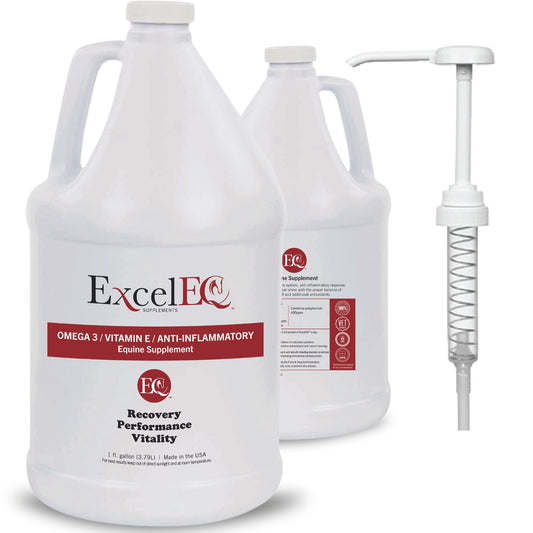Things to know.
First and foremost, it's important to know how to perform a physical exam on your horse (temperature, pulse, and respiration, also known as "TPR") and what the normal ranges are for each. The temperature of a horse is always taken rectally and can be done using a digital or mercury thermometer. Unlike with taking a temperature, there are multiple locations to take a horse’s pulse; the most common being at the heart girth, right behind the horse’s left elbow. Respiration can be measured correctly by starting a timer for 15 seconds and watching their rib cage to count how many breathes are taken in those 15 seconds. This result can be multiplied by 4 to calculate the total breathes per minute. See the following chart for the average range of TPR in horses.
|
Adult |
Newborn/Foal |
|
| Temperature |
99-101.5 F (37.2-38.3 C) |
99.5-102 |
| Pulse |
28-44 beats per minute |
80-100 beats per minute |
| Respiration |
10-24 breaths per minute |
20-40 breaths per minute |
| Mucous Membranes (gums) |
Moist, healthy pink color |
|
| Capillary Refill Time* |
Two seconds or less |
|
| Gut sounds |
“Rolling thunder”, gurgling, should be active!! |
|
*Time it takes for the gums to return to pink after being pressed with a finger
In addition to understanding basic horse health and physical exams, it is important to know basic first aid (for horses and humans) and how to use the equipment in your kit (such as giving IM or IV injections if required). Using a piece of tape to write the expiration date of the medication in your kit and replacing items as they are used can help keep your first aid kit up to date and ready to go!

"Preparing an equine first aid or emergency kit is a crucial way to ensure your preparedness."
Let’s start with Barn Basics:
Posting your contact information, as well as your veterinarian's contact information on your horse’s stall door can help barn staff know who to contact in the case of an emergency. The following list are basic first aid tools that should be kept in an easy to access location at your barn.
- Self-Adhesive bandage-such as Vetrap.
- Wound cleaning supplies-a Chlorhexidine cleaning solution or Betadine
- Stethoscope-for taking vitals and listing for gut sounds
- Thermometer- (digital or mercury) keep in mind that digital thermometers are faster but may need batteries replaced or kept in a temperature-controlled environment. Mercury thermometers tend to take longer to read and are easy to misread or miss use.
- Bandage Scissors-- designed with a rounded tip to not accidentally cut the horse while in use.
- Gauze, cotton, etc.-- useful for packing hooves, wounds, or cleaning a wound.
- Standing wraps – to wrap legs or use as a sling if a person becomes injured.
- Topical ointment such as Neosporin or ExcelRescue™ -for both people and horse superficial wounds!
- Peroxide or Thrushbuster--for getting rid of stubborn horse thrush in hooves.
- Epsom salt- for soaking hooves or drawing out swelling
- Notebook with pen or pencil- for times when tracking temperature, defecation, and urination is crucial (i.e., colic episodes).
- Medication- basic Non-Steroidal Anti-Inflammatory drugs (NSAIDs) such as Banamine or Bute.
- Sedatives--Dormosedan Gel can be given orally and takes about 30-45 minutes to kick in. If you know how to administer Im or IV shots, having Acepromazine or Dormosedan injectable solution in your first aid kit is extremely helpful when a horse panics and needs to be sedated in an emergency situation. If you are not familiar or comfortable with administering IV or Im shots, please wait for your veterinarian to do it.
- Syringes- 60-cc dose syringes with a catheter tip for administering oral medications as well as 10-cc syringes and hypodermic needles for injections.
- Gloves
- Duct tape- duct tape fixes everything! (and it's good for holding a hoof pack on)
- Electrolyte paste- especially crucial in the summer months when horses lose a lot of their electrolytes through sweat.

On the Road Again… Truck/Trailer Kit:
You’ll notice that many of the supplies for your barn kit should also be in your trailer. However, it is important to remember that most trailers experience high fluctuations in temperature throughout the year, and things can get tossed around when in motion. So, keeping your trailer equine emergency kit up to date and secure requires checking it before you hit the road, every time! I personally like to keep my trailer first aid kit in a plastic tote with a lid, for the smaller items (meds, syringes, etc.) and I have a Tupperware inside the kit.
- Wound cleaning supplies
- Gauze, cotton, etc.
- Bandage scissors & sharp knife-- keeping a sharp pocketknife on hand while traveling with your horses is extremely important. We never want to think about a situation where our horse getting stuck in the trailer, but if they should happen to fall while tied or get a foot stuck in their hay net, you’ll be forever grateful for that pocketknife!
- Duct tape
- Vetrap
- Topical antibiotic
- Bute/Banamine- Keep in mind that these medications may be temperature sensitive and moving them to and from the temperature-controlled tack room and the trailer, each time you travel, is a wise choice.
- Syringes- 60-cc dose syringes with a catheter tip for administering oral medications as well as 10-cc syringes and hypodermic needles for injections.
- Flashlight/ headlamp- even when you don’t think you’ll be traveling after dark!
- Gloves
- Clean set of pillow wraps and standing wraps
- Electrolyte paste- even if your horse usually doesn’t have issues with traveling, it can get extremely hot in trailers and replacing those electrolytes quickly can save a life!
Pack Light! Saddle Bag/Trail Ride Kit:
Since you have a fully stocked kit in your trailer, you should be able to pack light for the trail! Slipping these few things in a saddle bag or backpack while out on a trail ride should only take a few seconds.
- Quick clot- bleed stop for both horses and humans in case of serious injury
- Vetrap- a small roll should be fine.
- Scissors or a knife- I am more inclined to bring a pocketknife with me out into the wilderness, because it has many uses, but use caution if you need to cut a bandage that is on you or your horse.
- Sunscreen, bug spray, etc. – I like to pack a little travel size of each for myself and will pour some fly spray into a smaller bottle for my equine travelling partner!
Sources
- Essential Items For Equine First Aid
- Stocking Your Equine First Aid Kit
- Equine First Aid Essentials
- Equine Vital Signs
Spread the word
Facebook-f
Linkedin-in









